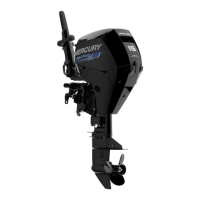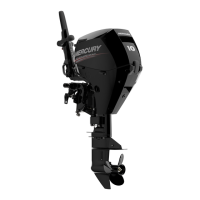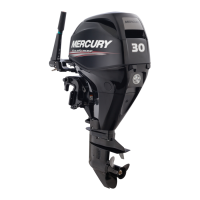
Do you have a question about the Mercury 15 FourStroke and is the answer not in the manual?
| Fuel System | Electronic Fuel Injection (EFI) |
|---|---|
| Displacement | 351 cc |
| Starting System | Electric |
| Weight | 45 kg (99 lbs) |
| Shaft Length | 381 mm (15 in) |
| Steering | Tiller |
| Gear Shift | Forward, Neutral, Reverse |
| Exhaust | Through Prop |
| Horsepower | 15 hp (11.2 kW) |
| Warranty | 3 Years |
Details compliance with the Recreational Craft Directive and associated standards.
Details compliance with the Safety of Machinery Directive.
Details compliance with the Electromagnetic Compatibility Directive.
Explains the process for transferring the limited warranty to a new owner.
Details requirements for registering the product for warranty coverage in the US and abroad.
Outlines warranty coverage for material and workmanship defects for specific regions.
Covers warranty for corrosion resistance for a period of three years.
Clarifies what services are covered and excluded under the limited warranty.
Defines the operator's duties for safe boat and outboard operation.
Provides essential guidance before starting and operating the outboard.
Explains the meaning of DANGER, WARNING, CAUTION, and NOTICE symbols.
Covers horsepower limits, high-speed operation, and remote control setup.
Details remote steering requirements and lanyard stop switch.
Provides safety tips for people in the water and passenger handling.
Discusses risks associated with wave jumping and underwater obstacles.
Covers carbon monoxide awareness and ventilation practices.
Guidance on selecting accessories and general safe boating practices.
Instructions on how to record the outboard's serial number for reference.
Technical specifications for the 15/20 4Stroke models for international markets.
Proper procedures for carrying, storing, and transporting the outboard.
Safety instructions for transporting portable fuel tanks.
Guidance on how to properly trailer a boat with the outboard.
Details recommended fuel types, octane ratings, and oxygenate usage.
Information on adverse effects of alcohol-based fuels on the engine.
Safe procedures for filling the outboard's fuel tank.
Specifies recommended engine oil viscosity and API classifications.
Instructions on how to correctly check the engine oil level.
Describes the functions and adjustments of the tiller handle.
Details the components and operation of remote control systems.
Covers general controls like steering friction adjustment.
Explains how to use the manual tilt lever and pin for positioning.
Describes the operation of the power tilt system using switches.
Details the low oil pressure and engine overheat warning systems.
Instructions on adjusting the trim tab to compensate for steering torque.
Covers pre-start checks, operating in different conditions, and auxiliary use.
Guidelines for breaking in the engine to ensure longevity and performance.
Step-by-step instructions for starting the engine using tiller or remote controls.
How to properly shift gears using tiller or remote controls.
Procedures for safely stopping the engine.
Instructions for starting the engine using the emergency starter rope.
Importance of periodic inspections and maintenance for optimal condition.
Explanation of the emission certification label and its specifications.
Lists checks and tasks required before, after, and at specific hour intervals.
Procedures for flushing the cooling system after use in various water conditions.
Covers top cowl, battery inspection, and exterior finish care.
Guidance on inspecting fuel lines, filters, and system safety.
Focuses on securing steering link rod fasteners and cable adjustments.
Information on inspecting and replacing corrosion control anodes.
Detailed steps for replacing the propeller and related parts.
Covers fuse replacement, spark plug inspection, and timing belt inspection.
Procedures for changing engine oil and its capacity.
Identifies key lubrication points and recommended lubricants.
Instructions for draining, refilling, and checking gearcase lubricant.
Guidance on checking and refilling power tilt and trim fluid.
Immediate service requirements for outboards that have been submerged.
Procedures to protect the outboard from rust, corrosion, and freezing.
Steps for protecting external and internal engine components during storage.
Instructions for draining and refilling the gearcase lubricant for storage.
Recommended positions for storing the outboard to prevent damage.
Guidance on storing and recharging the boat battery.
Diagnosing problems like starter not cranking or engine not starting.
Troubleshooting erratic engine running and performance loss.
Addressing problems related to the battery not holding charge.
Advice on using authorized dealers and service away from home.
Information on how to inquire about replacement parts and accessories.
Contact information for Mercury Marine service offices worldwide.
Ensuring correct horsepower and transom height for installation.
Importance of neutral safety switch to prevent starting in gear.
Guidance on selecting and installing genuine or approved accessories.
Procedures for safely lifting and mounting the outboard onto the transom.
Steps for installing steering cables and link rod fasteners.
Connecting remote wiring harness and control cables to the engine.
Procedures for mounting the battery and connecting cables.












